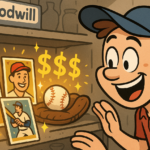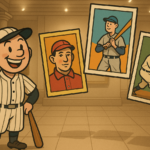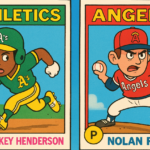Last Updated on October 8, 2024 by Matt Musico
If you’ve ever wondered which hitters are the Reds single season home run leaders at each position, then you’re in the right place. Outside of pitcher and designated hitter, each player had to qualify for the batting title. Each player also had to man their position for at least 75% of the season in question.
After you’re done checking this out, head on over to the Reds’ all-time and single-season home run leaderboards.
Related: A Complete Guide to Single-Season (& Single-Game) HR Performances
Reds Single Season Home Run Leaders
Catcher: Johnny Bench, 1970: 45 Home Runs

For a long time, Johnny Bench was the standard for catchers on offense. This was proof of that. He took home two National League MVP Awards, one in 1970 and another in 1972. He led the league in homers and RBI on both occasions. His best of everything came in ’70, as those 45 dingers, 148 RBI, and .932 OPS were all single-season bests for the Hall of Fame backstop. Oh, and he added Gold Glove defense for good measure.
Bench enjoyed playing in front of the home crowd. Through 341 plate appearances in Cincinnati, he slashed .302/.359/.669 with 30 homers and 89 RBI. There’s no comparison between that and his road numbers, which landed at .283/.330/.502 with 15 homers and 59 RBI in 330 plate appearances.
June and July were Bench’s only double-digit homer months, and he made them count. He clobbered 11 dingers in each, giving him just about half of his season-long total.
Pitcher: Tom Parrott (1894), Hal Jeffcoat (1957), Michael Lorenzen (2018): 4 Home Runs
A good ol’ fashioned three-way tie at pitcher that will remain in perpetuity because of the Universal Designated Hitter. You love (and hate) to see it.
Michael Lorenzen seemed to be cut from the same cloth as Mike Hampton. You know, the kind of pitcher you can call upon as a pinch hitter when he wasn’t on the mound. He was predominantly a reliever in 2018, posting a 3.11 ERA in 81 innings pitched. Lorenzen also posted a .290/.333/.710 line with four homers and 10 RBI at the plate. He collected nine hits overall that year, so just about half of them left the yard.
Tom Parrott went 17-19 with a 5.60 ERA over 308.2 (!) innings. He posted a career 5.33 ERA, but he tried to make up for it at the plate. Parrott owned a .773 OPS for his career with 15 homers.
Hal Jeffcoat tossed 697 innings as a big-league pitcher, and the majority of his work came in 1957. He tossed a career-high 207 frames, leading to a 12-13 record and 4.52 ERA. The right-hander slugged 26 total home runs, but he also spent the first part of his career as an outfielder.
First Base: Ted Kluszewski, 1954: 49 Home Runs
Ted Kluszewski’s power peak was kind of short, but man, was it powerful. His four All-Star Game selections came consecutively between 1953 and 1956. He didn’t finish any of these years with fewer than 35 homers, and the left-handed hitter surpassed the 40-homer plateau three times. Klueszewski also racked up three top-10 MVP finishes.
His highest finish in the MVP race came in ’54, when he led the league in both homers and RBI (141). Similar to Bench, Big Klu enjoyed hitting in Cincinnati, as 34 of his 49 dingers came at home.
The first baseman had a tremendous first half, slashing .313/.398/.606 with 22 homers and 68 RBI in 344 plate appearances. Kluszewski had 30 fewer trips to the plate in the second half but outdid each of those numbers quite handily. He slashed .341/.414/.681 with 27 homers and 73 RBI.
Second Base: Brandon Phillips, 2007: 30 Home Runs

Brandon Phillips enjoyed a 17-year MLB career. He finished with double-digit homers on 11 occasions, but none were better than 2007. It was the first time he surpassed the 20-homer plateau, and it’d be the only time he’d get to 30. Phillips made it count by also stealing 32 bases, which was another career-high mark.
The second baseman never hit more than six homers in a single month, but he stayed consistent throughout the year. He also never hit fewer than four dingers in a month. The symmetry in some of his splits is crazy, too.
Phillips hit 17 homers and stole 16 bases at home while slugging 13 dingers with 16 thefts on the road. Before the All-Star break, Phillips had 17 homers and 16 steals. After the midsummer classic, he finished the year with another 13 homers and 16 steals. Only in baseball.
Shortstop: Barry Larkin, 1996: 33 Home Runs
Barry Larkin and Phillips followed the same kind of blueprint from the standpoint of power. Larkin produced nine seasons of double-digit homers during his 19-year Hall of Fame career. He reached or surpassed 20 twice, with the 1996 season being the only time he got above 30. And like Phillips, ’96 was a 30-30 campaign for Larkin, as he added 36 steals to the party.
The shortstop’s power was solid through the first half, as he slugged 12 homers by the All-Star break. That either matched or exceeded 14 of his season-long totals. But then he came back and hit 21 in the second half. That number alone is more than any other season in his career, outside of 1996, of course.
His last three months of the year were remarkably consistent. Larkin’s OPS went from 1.034 to 1.047 to 1.073, and he hit eight homers in each of July, August, and September.
Third Base: Eugenio Suarez, 2019: 49 Home Runs
Eugenio Suarez’s power progression between 2014 and 2019 will always catch my eye when looking at his stat page. It went like this: 4, 13, 21, 26, 34, 49. While he didn’t also earn a trip to the All-Star Game, his 15th-place finish in NL MVP voting is the highest he’s earned to this point in his career (entering 2023).
Great American Ball Park is known as a hitter-friendly environment, but Suarez didn’t exactly take advantage. Sure, he slugged 24 homers in Cincy, but the other 25 came as a visiting player. Similar to Larkin, Suarez caught fire over the season’s final three months.
He slugged 29 of his 49 homers after the All-Star break, which included double-digit homers in July, August, and September. During those three months, Suarez slugged 32 homers with 55 RBI and a .296/.388/.682 line.
Reds Single Season Home Run Leaders
Left Field: George Foster, 1977: 52 Home Runs

George Foster is currently the only Reds hitter to slug at least 50 homers in one season. This performance in 1977 was right in the middle of his peak. He won NL MVP honors while leading the league in homers, RBI (149), and runs scored (124). The year before, he finished second in MVP voting, and he finished sixth in 1978. Foster was the leading RBI man each year and slugged 40 in ’78 to lead the league again.
He slugged 31 of these 52 home runs as a visiting player, and his splits between the first and second half were quite similar. The outfielder slashed .316/.374/.629 in 382 plate appearances before the All-Star Game. After the midsummer classic, Foster hit .326/.391/.634 in 307 plate appearances.
The right-handed hitter slugged three homers in 19 games during the season’s first month. But after that, he didn’t slug fewer than eight in any of the final five months. His power numbers in July and August were nearly identical, too. Foster hit 12 homers with 29 RBI in July and followed that up with 12 homers and 28 RBI in August.
Center Field: Ken Griffey Jr., 2000: 40 Home Runs
Ken Griffey Jr. shares the single-season home run record for center fielders with Hack Wilson, but he did it while with the Seattle Mariners. The 2000 season was his first with the Reds. It was similar to what he did during his 11 years in the Pacific Northwest.
This was the fifth straight season Griffey slugged at least 40 homers, and the sixth time he did it over seven years. His slugging percentage was similar between the first half (.550) and the second half (.564), but since he played in 29 more games before the All-Star break, that’s where the majority of his homers happened (28 vs. 12).
The Kid also enjoyed starting his night off with a dinger. He slugged eight homers in the first inning during the 2000 season, which was his highest number of any inning that year.
Right Field: Wally Post, 1955: 40 Home Runs

Wally Post enjoyed five seasons of 20-plus homers, with two of those performances landing above 30. Those 30-plus years came consecutively (1955-56), and he’d never hit more than 22 in a year the rest of his career.
Post appeared in parts of five seasons before that 40-homer campaign in ’55. He slugged a total of 22 homers during this time, with 18 of them coming in 1954.
Despite getting nearly 200 more plate appearances against righties, Post hit nearly the same number of homers vs. right-handed pitching (23) as he did against southpaws (17). He also hit more dingers in the second half (21) than the first half (19) despite accruing 14 fewer player appearances.
Post was solid most of the year outside of a slow start in April, but July and August was where some of his best work happened. Across 304 trips to the plate, the outfielder slashed .330/.401/.589 with 18 homers, 55 RBI, and 60 runs scored.
Designated Hitter: Jesse Winker, 2020: 9 Home Runs
The 2020 season was weird for everyone, but it was the beginning of a power breakout for Jesse Winker. After hitting 16 homers in 384 plate appearances during 2019, it took him just 183 trips to the plate to slug 12. He followed that with another 24 in 110 games, which helped lead to his first All-Star Game selection.
Winker’s monthly splits are incredibly interesting because his production was concentrated in August. Through seven July games, he posted a .436 OPS. That number only went up slightly to .552 in 19 games played in September. But in August, he slashed .369/.459/.798 (a 1.257 OPS) with 10 homers and 16 RBI.
Want to see the Reds slug dingers in person? Grab tickets from our friends at Vivid Seats. And before you get to the stadium, make sure you’re decked out in the right gear. Get official Reds merch from the MLB Shop or a ‘Big Dinger Energy’ shirt from our apparel store.





Leave a Reply